Microbial Community Dynamics of Soybean (Glycine max) Is Affected by Cropping Sequence
- PMID: 33643263
- PMCID: PMC7904696
- DOI: 10.3389/fmicb.2021.632280
Microbial Community Dynamics of Soybean (Glycine max) Is Affected by Cropping Sequence
Abstract
The microbial composition of the rhizosphere soil could be an important determinant of crop yield, pathogen resistance, and other beneficial attributes in plants. However, little is known about the impact of cropping sequences on microbial community dynamics, especially in economically important species like soybean. Using 2-year crop sequences of corn-soybean, canola-soybean, and soybean-soybean, we investigated how crops from the previous growing season influenced the structure of the microbiome in both the bulk soil and soybean rhizosphere. A combination of marker-based Illumina sequencing and bioinformatics analyses was used to show that bacterial species richness and evenness in the soybean rhizosphere soil were similar following canola and soybean compared to a previous corn sequence. However, fungal species richness and evenness remained unaffected by crop sequence. In addition, bacterial and fungal species diversity in both the bulk and soybean rhizosphere soil were not influenced by crop sequence. Lastly, the corn-soybean sequence significantly differed in the relative abundance of certain bacterial and fungal classes in both the soybean rhizosphere and bulk soil. While canola-soybean and a continuous soybean sequence did not, suggesting that a preceding corn sequence may reduce the occurrence of overall bacterial and fungal community members. For the present study, crop sequence impacts bacterial diversity and richness in both the bulk soil and soybean rhizosphere soil whereas fungal diversity and richness are resilient to crop sequence practices. Together, these findings could help drive decision making for annual crop and soil management practices.
Keywords: canola; corn; crop sequence; phytomicrobiome; soybean.
Copyright © 2021 Bolaji, Wan, Manchur, Lawley, de Kievit, Fernando and Belmonte.
Conflict of interest statement
The authors declare that the research was conducted in the absence of any commercial or financial relationships that could be construed as a potential conflict of interest.
Figures

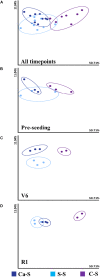
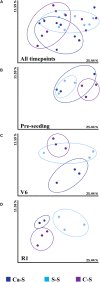
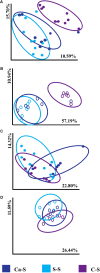
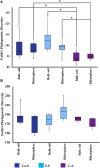
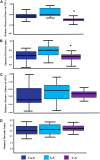
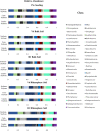
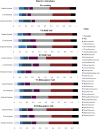
Similar articles
-
The shift of soil microbial community induced by cropping sequence affect soil properties and crop yield.Front Microbiol. 2023 Feb 16;14:1095688. doi: 10.3389/fmicb.2023.1095688. eCollection 2023. Front Microbiol. 2023. PMID: 36910216 Free PMC article.
-
Effects of different 3-year cropping systems on soil microbial communities and rhizoctonia diseases of potato.Phytopathology. 2006 Jan;96(1):68-79. doi: 10.1094/PHYTO-96-0068. Phytopathology. 2006. PMID: 18944206
-
Effects of Rhizophagus intraradices on soybean yield and the composition of microbial communities in the rhizosphere soil of continuous cropping soybean.Sci Rep. 2022 Oct 17;12(1):17390. doi: 10.1038/s41598-022-22473-w. Sci Rep. 2022. PMID: 36253456 Free PMC article.
-
Hiseq Base Molecular Characterization of Soil Microbial Community, Diversity Structure, and Predictive Functional Profiling in Continuous Cucumber Planted Soil Affected by Diverse Cropping Systems in an Intensive Greenhouse Region of Northern China.Int J Mol Sci. 2019 May 28;20(11):2619. doi: 10.3390/ijms20112619. Int J Mol Sci. 2019. PMID: 31141960 Free PMC article.
-
Impacts of Binary Oxide Nanoparticles on the Soybean Plant and Its Rhizosphere, Associated Phytohormones, and Enzymes.Molecules. 2023 Jan 30;28(3):1326. doi: 10.3390/molecules28031326. Molecules. 2023. PMID: 36770994 Free PMC article. Review.
Cited by
-
Tapping into Plant-Microbiome Interactions through the Lens of Multi-Omics Techniques.Cells. 2022 Oct 17;11(20):3254. doi: 10.3390/cells11203254. Cells. 2022. PMID: 36291121 Free PMC article. Review.
-
The shift of soil microbial community induced by cropping sequence affect soil properties and crop yield.Front Microbiol. 2023 Feb 16;14:1095688. doi: 10.3389/fmicb.2023.1095688. eCollection 2023. Front Microbiol. 2023. PMID: 36910216 Free PMC article.
-
Metagenomic analysis of soybean endosphere microbiome to reveal signatures of microbes for health and disease.J Genet Eng Biotechnol. 2023 Aug 16;21(1):84. doi: 10.1186/s43141-023-00535-4. J Genet Eng Biotechnol. 2023. PMID: 37584775 Free PMC article.
References
-
- Agomoh I. V., Drury C. F., Phillips L. A., Reynolds W. D., Yang X. (2020). Increasing crop diversity in wheat rotations increases yields but decreases soil health. Soil Sci. Soc. Am. J. 84 170–181. 10.1002/saj2.20000 - DOI
-
- Aguirre-von-Wobeser E., Rocha-Estrada J., Shapiro L. R., de la Torre M. (2018). Enrichment of Verrucomicrobia, Actinobacteria and Burkholderiales drives selection of bacterial community from soil by maize roots in a traditional milpa agroecosystem. PLoS One 13:e0208852. 10.1371/journal.pone.0208852 - DOI - PMC - PubMed
-
- Ai C., Zhang S., Zhang X., Guo D., Zhou W., Huang S. (2018). Distinct responses of soil bacterial and fungal communities to changes in fertilization regime and crop rotation. Geoderma 319 156–166. 10.1016/j.geoderma.2018.01.010 - DOI
-
- Ashworth A. J., DeBruyn J. M., Allen F. L., Radosevich M., Owens P. R. (2017). Microbial community structure is affected by cropping sequences and poultry litter under long-term no-tillage. Soil Biol. Biochem. 114 210–219. 10.1016/j.soilbio.2017.07.019 - DOI
LinkOut - more resources
Full Text Sources
Other Literature Sources

